Profile: Jack Lockerby & River Software

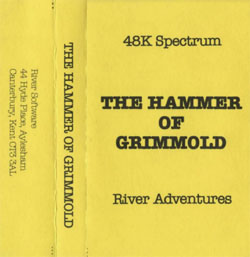 With over thirty-five games to his name, Jack A. Lockerby was one of the most prolific text adventure authors of the 8-bit era. Producing homegrown games for the ZX Spectrum, Commodore 64, and the 16-bit Atari ST, many of his River Software titles were also ported by The Guild & The Adventure Workshop to CP/M-capable machines such as the Amstrad CPC and PCW.
With over thirty-five games to his name, Jack A. Lockerby was one of the most prolific text adventure authors of the 8-bit era. Producing homegrown games for the ZX Spectrum, Commodore 64, and the 16-bit Atari ST, many of his River Software titles were also ported by The Guild & The Adventure Workshop to CP/M-capable machines such as the Amstrad CPC and PCW.
Jack Lockerby was born in Fulham, London, in the early 1920s but during his later years he lived in Aylesham, a village near the picturesque city of Canterbury in Kent. A sexagenarian and a father of four, Jack's computer career started not long after he had taken early retirement from his job as a mining engineer. Although he happily spent his newly acquired hours of leisure gardening, reading, or visiting the theatre and cinema, he was looking for a fresh challenge.
His wife had heard him enthuse about the new wave of microcomputers that were becoming popular, so in 1983 she bought him a 16K ZX Spectrum for Christmas; a move that Jack jokingly said she later regretted. The Spectrum hooked Jack immediately and his basic model was soon upgraded to a 48K machine. He tried the various arcade games that were on offer at the time, but they didn't really hold his interest, although he did manage to complete all twenty levels of Manic Miner!
His own real-life subterranean career had given him a firm grounding in maths and science, which helped as he learned about programming his new machine and, after purchasing a copy of The Mountain of Ket, he also became interested in text adventure games. Combining both skills, Ket was eventually solved by breaking into the BASIC program and nosing around.
 Jack moved on to bigger, more detailed offerings from publishers like Level 9. The Austin's Dungeon Adventure was a firm favourite, even years later. Jack recalled, in an interview with Syntax magazine, that it had everything he wanted in a game, "…excellent descriptions, plenty of devious puzzles… I played it non-stop for weeks until I finally finished it, with the help of the hint sheet, I might add." With its vast scenario, he regarded it a true masterpiece and deemed it particularly atmospheric; high praise indeed from a man who had spent his career underground.
Jack moved on to bigger, more detailed offerings from publishers like Level 9. The Austin's Dungeon Adventure was a firm favourite, even years later. Jack recalled, in an interview with Syntax magazine, that it had everything he wanted in a game, "…excellent descriptions, plenty of devious puzzles… I played it non-stop for weeks until I finally finished it, with the help of the hint sheet, I might add." With its vast scenario, he regarded it a true masterpiece and deemed it particularly atmospheric; high praise indeed from a man who had spent his career underground.
As Jack delved deeper into the world of adventures, subscribing to magazines like The Micro Adventurer, he turned his thoughts to writing his own game. He had dabbled with BASIC, typing in listing from magazines, but the arrival of Gilsoft's seminal adventure system The Quill gave Jack the tools he needed to create a fast, machine code-powered adventure game.
The Hammer of Grimmold was the first game he produced. Jack sent it off to the Adventurers Club Ltd, whose newsletters he'd subscribed to, to see if the organisation would be interested in selling it on his behalf. It was a very rough and ready version of the game (Jack was still learning the intricacies of The Quill) but it showed enough potential to interest the Adventurers Club. However, while he worked on producing a more polished version of Grimmold, ACL were working through some issues of their own, and Jack ended up selling the game himself.
Classified adverts in magazines such as PCW and C&VG were enough to start the ball rolling and in that first year (1986) Grimmold was joined by Matchmaker, The Jade Necklace, Realm of Darkness, Mutant, Witch Hunt, and Lifeboat. The venture became known as River Software.
Many of Jack's early games were produced in collaboration with Roger Betts, who was married to Jack's youngest daughter. Roger had caught the computing bug from his father-in-law, buying his own Spectrum 48K and avidly joining in on Jack's adventure gaming journey.
The games that they released were credited to River Software alone, rather than to Jack or Roger, which reflected their approach to creating the software. Jack discussed their writing process in an early interview with Jim O'Keeffe of Adventure Probe, "We tend to design the games individually, and then have long talks over the setting of puzzles and the like. I would say that I am more the ideas man, and Roger is the programmer. In fact, he much prefers to sit down and work out a routine to solve a problem that has me stumped, rather than design and write a game."
Jack found that there was great satisfaction to be gained from being in at the birth of an idea to the fruition of the completed adventure. "It's always hard for me to start a game," Jack told Sinclair User in November 1990, "but once I get the basic shell sorted out, ideas seem to be plentiful."
The settings often came from real-life events or from books that the pair had read. Matchmaker was inspired by the wedding of Prince Andrew and Sarah Ferguson. Jack created Witch Hunt after reading a book on the walks of Scotland. Roger's sense of humour is evident in the titles he created, like Lifeboat and Davy Jones Locker. His interest in science fiction resulted in Mutant, the Bounty Hunter and the Domes of Sha too. In later years classic novels, such as A Christmas Carol (The Miser), Treasure Island, The Wizard of Oz, The Thirty-Nine Steps, and Kidnapped provided the framework for Jack's games but there were still plenty of adventures that were based on original concepts, such as the brainteasing Civil Service "trilogy" (that started in Norman's Lament) and multiple games set in Lockerby's imaginative fantasy worlds (such as Dark Tower and The Citadel).
 |
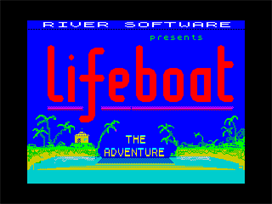 |
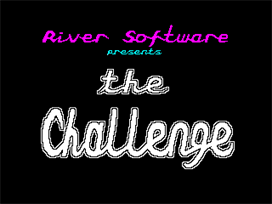 |
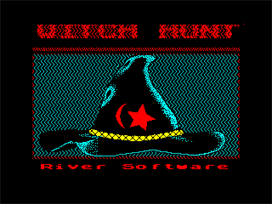 |
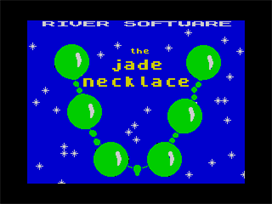 |
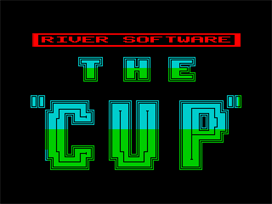 |
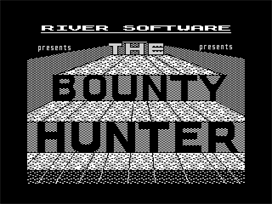 |
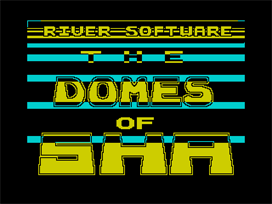 |
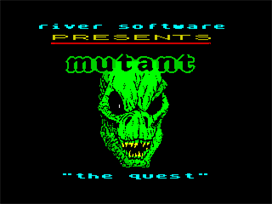 |
The initial batch of eight River Software games were Quilled and were all released for both the ZX Spectrum and its main competitor, the Commodore 64 during the years 1986 and 1987. It was relatively unusual for a small, homegrown outfit to target platforms from two different manufacturers and catering for the different machines, with their different specifications, was challenging. The C64 had the bonus of a wider, 40-character screen display which allowed games space to breathe. The Spectrum, though, was a much easier machine to work with and develop on, particularly when it came to the speed of loading or saving. Despite these issues, and the fact that the Spectrum versions outsold the C64 ports by a factor of 12 to 1, River continued to support the Commodore machine.
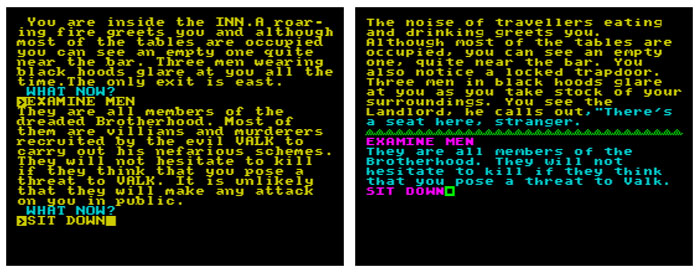 |
| (Above: The Hammer of Grimmold for ZX Spectrum. Left is an early Quilled version, right is the PAWed remake) |
The gap between the two platforms became much greater (and a lot more obvious) once Gilsoft, the company behind the Quill, released their new improved system, the Professional Adventure Writer. The PAW was much more powerful that its predecessor but was only ever officially made available for the ZX Spectrum and CP/M machines, such as the Amstrad CPC and PCW. Jack and Roger eagerly and quickly took advantage of the power of the PAW. Their ports of existing River Quilled games were the earliest commercial games produced using the new system. These rewritten & reprogrammed adventures featured larger maps, an improved parser, additional (or more complex) puzzles, and a whole host of other improvements. They replaced the previous Quilled ZX Spectrum versions in the River catalogue, which were never sold again.
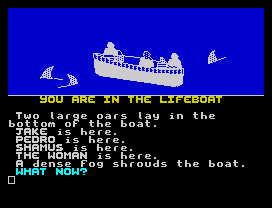 |
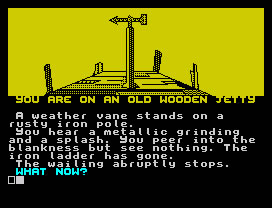 |
 |
 |
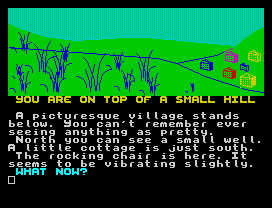 |
 |
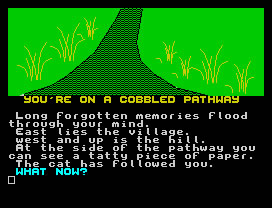 |
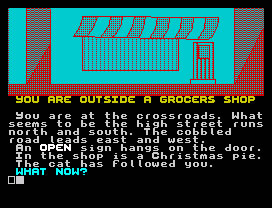 |
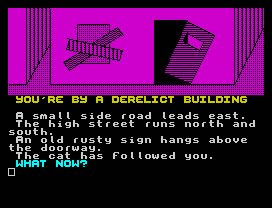 |
| (Above: The game Lifeboat was unusual for a River Software adventure as it included graphical illustrations for each location) | ||
The PAW allowed Roger and Jack to gradually develop a distinctive screen layout which perfectly suited their style of games, incorporating a unique "instant update" system. As Paul Rigby remarked, in his Crash review of Treasure Island, one of the benefits of River's unique presentation style was that it helped each game move swiftly, "Only part of the location description changes from move to move. Items are merely added or taken away from the description, speeding up play wonderfully."
 |
| (Above: River's "instant update" in action... as each command is entered the location decription at the top of the screen automatically updates) |
The clear and functional presentation, and the succinct text, meant players could focus on the main selling point of a River game, the puzzles. Jack and Roger's games always featured a good mix of easy, more difficult, and darn-right-devious conundrums. They were the type of games where you could turn off the computer in frustration, walk away from the keyboard, and then suddenly find yourself rushing back to load up the game again when the idea of something new to try suddenly came to you. Despite the odd occasion when the parser required you to be overly specific, it was rare to feel that your inability to make progress was Jack or Roger's fault.
The River game worlds were logical and meticulously organised. Something that Lockerby said that he wasn't himself. He explained to Adventure Probe that… "I'm not efficient… I tend to keep things in shoe boxes and even then I can seldom put my finger on any particular item at any given time." Jack seems to have had a particular fascination with containers, as they crop up with great regularity in his games. The presence of a backpack, to carry objects in, was fairly unusual and was specifically noted in reviews of River's earliest adventures.
"I don't like to be told that 'Your Hands are full'…", Jack wrote, "…in the vast majority of the games that I have designed I always try to include either a knapsack, a rucksack, a holdall or even a magic sack (that will hold everything including the kitchen sink). The fact that all these items can also be worn is another plus in freeing the hands for other tasks."
Containers, and related object juggling, were often part of Jack's puzzles. A player would need to prepare carefully if they were going to attempt anything particularly athletic.
"I think it entirely logical when climbing a tree or climbing up and down a ladder to have at least one hand free. Whilst acting as Tarzan and swinging on a rope across a chasm then both hands should be available for the task."
One of the Jack's most memorable container-based puzzles featured in the game Dark Tower where the player must actually climb inside the game's magic sack several times in order to get past certain obstacles. Containers were extremely easy to implement in the PAW and going forward Jack and Roger used the Gilsoft tool for all the Spectrum versions of the River adventures, with the Quill being retained as the system of choice for the C64. Not content with just two formats to think about, River even started publishing on a third platform: the 16-bit Atari ST.
 Although Jack and Roger were not a fan of the GAC, Incentive's Graphic Adventure Creator for 8-bit machines, they thought that the Atari ST version, the STAC, was a great improvement. Over the years they ported across twelve of their adventures using the system. Sadly, a thirteenth game, Roger Betts' particularly ambitious conversion of Bounty Hunter, does not seem to have materialised even though it was in development for over eighteen months.
Although Jack and Roger were not a fan of the GAC, Incentive's Graphic Adventure Creator for 8-bit machines, they thought that the Atari ST version, the STAC, was a great improvement. Over the years they ported across twelve of their adventures using the system. Sadly, a thirteenth game, Roger Betts' particularly ambitious conversion of Bounty Hunter, does not seem to have materialised even though it was in development for over eighteen months.
Their foray into the 16-bit market wasn't particularly profitable, despite an agreement signed for a compilation of three of the games to be published by the British Atari user's magazine, Page 6. "Home grown adventures on the Atari do NOT sell," explained Lockerby at the time, "The buying public much prefer high priced games that use the full memory of the machine. And who can blame them? Certainly not me!"
Instead of chasing the 16-bit market, by producing text-heavy or graphically enhanced titles, River continued to concentrate on the older Spectrum and Commodore machines. Like many homegrown software producers at the time, River Software's games were distributed exclusively by mail order. Their packaging could only very generously be described as functional, with rather basic, plain photocopied inlays that kept costs low.
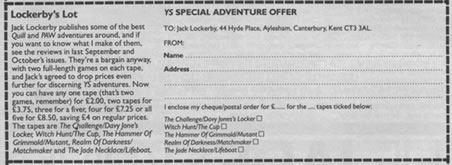 Any profits were low too, so there was no money for large marketing campaigns. Sales were by word of mouth or came after reviews in fanzines and magazines. Jack's games usually scored highly, particularly in the Spectrum magazine Your Sinclair where his River Software discount coupons also appeared. However, a particularly appealing offer, of 10 adventures for £8.50, almost caused Jack to throw in the towel and close down River Software.
Any profits were low too, so there was no money for large marketing campaigns. Sales were by word of mouth or came after reviews in fanzines and magazines. Jack's games usually scored highly, particularly in the Spectrum magazine Your Sinclair where his River Software discount coupons also appeared. However, a particularly appealing offer, of 10 adventures for £8.50, almost caused Jack to throw in the towel and close down River Software.
"When the issue [of Your Sinclair] came out," Jack recalled in a letter to Adventure Probe, "I was on holiday and when I arrived home there was a veritable flood of envelopes on the door mat, awaiting inspection."
The actual marketing, duplication and admin was not something that Lockerby enjoyed; especially as the games had to be laboriously copied one at a time. After the coupon's appearance in Your Sinclair he dispatched over 550 tapes, over a period of six to seven weeks, and was relieved when the orders from that particular offer dried up.
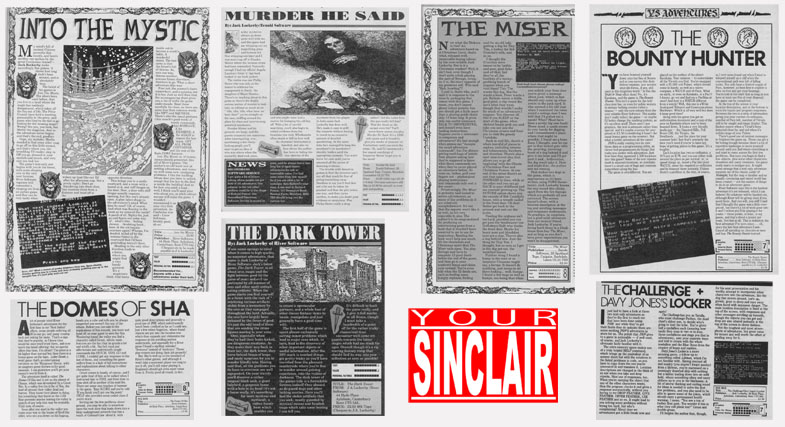 |
| (Above: River Software games were rated highly by Your Sinclair... The Challenge / Davy Jones Locker, 7/10 - The Bounty Hunter, 7/10 The Miser, 8/10 - Treasure Island, 8/10 - Domes of Sha, 8/10 Into the Mystic, 8/10 - Murder – He Said, 9/10 The Dark Tower, 10/10) |
Jack decided to let others take on what he considered the boring aspects of selling the games as it allowed him to spend more time writing adventures and working in his garden. He entered into an agreement for his friend, John Wilson of Zenobi Software to distribute the Spectrum & ST games from the River Software catalogue. Adventure Probe eventually took on responsibility for the Commodore 64 titles and The Guild & The Adventure Workshop would port many of Jack and Roger's games to the Amstrad CPC & PCW machines.
Going forward, Jack's main focus would be on producing new ZX Spectrum adventures. They were all published by Zenobi and he became one of their most popular and best-selling authors. The releases continued, usually at a steady rate of two or three games a year, until The Islands of Sinbad in 1997.
In just over ten years, the River Software duo of Jack Lockerby and Roger Betts had written and released thirty-five different games for the ZX Spectrum. Twenty of them had made it onto the Commodore 64, twelve of them had been released for the Atari ST, and eighteen of them were ported to the various Amstrad CPC & PCW machines that ran CP/M.
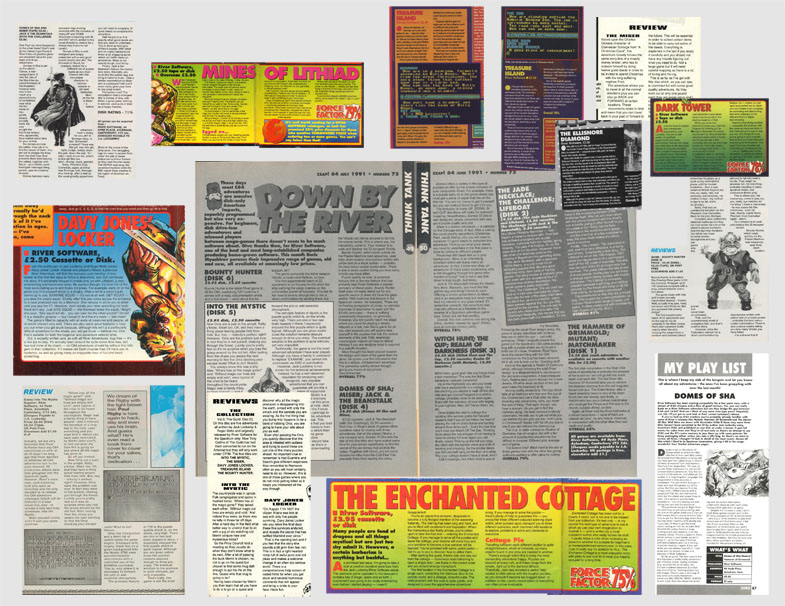 |
| (Above: A selection of some of the many reviews of River games that appeared in publications like Zzap64!, Zero, Your Commodore, Sinclair User, and Crash over the years.) |
By 2001, Jack had moved to a new address which was too small to accommodate a computer. His final game, The Scarlett Pimpernel, was due to be published by Adventure Probe. At the time of writing, it is unclear if it was ever released, as it is not archived online.
Jack died on 12th April 2014 at the age of 93. He left behind a remarkable collection of adventure games. Videogames are still a relatively new medium, so there are not yet many text adventure authors whose centenary can be celebrated, but Jack Lockerby is one of them; over a hundred years after his birth, we are still enjoying his great games.
Further Reading, References, Sources and Downloads:
|